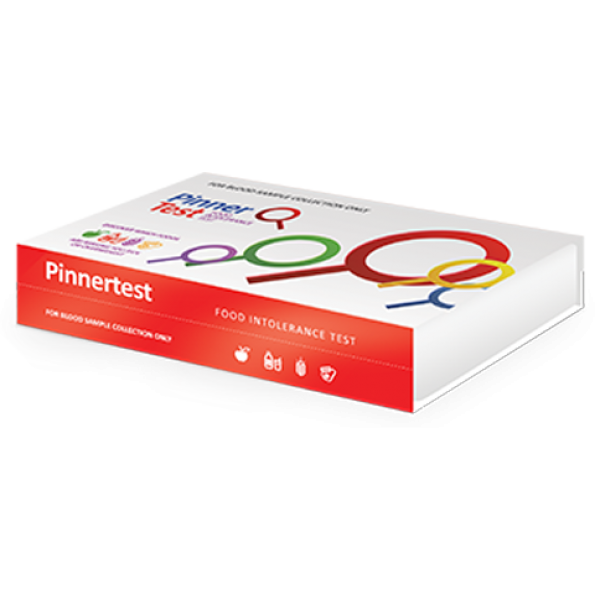Pinner Test - 200 Foods Intolerance Test
Pinnertest is an advanced and most accurate food intolerance test using a Microarray IgG method lab to test for 200 food items.
Foods tested:
| GRAINS | FISH/SEAFOOD | VEGETABLES | FRUITS | SPICES/HERBS | DRINKS |
| Barley | Anchovy (Hamsi) | Artichoke | Acai Berry | Allspice | Aniseed |
| Broad Bean | Blue Fish | Asparagus | Apple | Basil | Chamomile |
| Buckwheat | Bonito | Aubergine | Apricot | Capari | Cocoa Bean |
| Chickpea | Crab | Beetroot | Avocado | Cardamom | Coffee |
| Corn (Maize) | Eel | Bell Pepper | Banana | Chili Pepper | Cola (Cola Nut) |
| Gluten (Gliadin) | Haddock | Broccoli | Blackberry | Cinnamon | Echinacea |
| Haricot Bean | Horse Mackerel | Cabbage | Blackcurrant | Clove | Fennel |
| Lentils | Lobster | Carrot | Blueberry | Coriander | Ginseng |
| Millet | Mackerel | Cauliflower | Cantaloupe/Melon | Cumin | Hibiscus |
| Oat | Mullet | Celery | Cherry | Garlic | Jasmin |
| Quinoa | Mussel | Chard | Cranberry | Ginger | Mate |
| Rice | Octopus | Chicory | Currant | Hops | Nettle |
| Rye | Oyster | Courgette | Date | Juniper | Papaya |
| Soybean | Salmon | Cow Pea | Fig | Laurel | Rooibos (Redbush |
| Wheat | Sardine | Cress | Grape | Lavender | Rosehip |
| Sea Bass | Cucumber | Grapefruit | Melissa | Sage | |
| SeaBream | Dandelion | Guava | Mint | Sahlep (Orchis) | |
| DAIRY | Shrimp | Dill | Kiwi | Mustard Seed | Tea |
| Sole | Grape Leaf | Lemon | Nutmeg | tea) | |
| Cows Milk | Squid | Jerusalem artichoke | Lime | Peppercorn | Tilia(Linden) |
| Egg White | Sword Fish | Kidney Bean | Lychee | Rosemary | |
| Egg Yolk | Trout | Leek | Mandarin Orange | Saffron | SEEDS |
| Goat's Milk | Tunafish | Lettuce | Mango | Thyme | |
| Sheep's Milk | Turbot | Mushrooms | Mulberry | Turmeric | Almond |
| Whelk | Okra | Oleaster | Vanilla | Black Cumin | |
| MEAT | Onion | Olive | Brazil | ||
| Parsley | Orange | Canola | |||
| Beef | Pea | Peach | Cashew | ||
| Chicken | Potato | Pear | Chestnut | ||
| Duck | Purslane | Pineapple | Coconut | ||
| Lamb | Radicchio | Plum | Flaxseed | ||
| Pork | Red cabbage | Pomegranate | Hazelnut | ||
| Quail | Red Radish | Raspberry | Hemp | ||
| Rabbit | Rocket | Strawberry | Peanut | ||
| Turkey | Rose | Walnut | Pine Nut | ||
| Senna | Watermelon | Pistachio | |||
| Spinach | Sesame Seed | ||||
| String Bean | Sunflower Seed | ||||
| Tomato | |||||
| Turnip | |||||
About the test:
Differentiates the active and passive intolerances
Checks IgG
Very high reproducibility rate
Highly Precise results compared to previous technologies
No fasting required
Pinnertest is the standard protocol for most of the Nutritionists in Europe and it has reached almost a half million clients. Before creating nutrition plans for clients, most of the Nutritionists and Dietitians, in European countries, require a Pinnertest report as a baseline to target individual sensitivities.
The difference between Pinnertest and other Food Intolerance Tests is that, thanks to our 3 year old newest update to our test method, Pinnertest can finally identify the ACTIVE and PASSIVE food intolerances.
This means that the number of food intolerant results that clients were receiving from the old technology tests has now been reduced to a few permanent intolerances. For example, if the client had 30 foods to avoid from the old tests, now with Pinnertest they will need to avoid 2 to 5 results now. Pinnertest will eliminate the temporary intolerances that were caused by temporary overeating certain foods or temporary gastrointestinal problems.
Additionally, the reproducibility rate for Pinnertest, even after 6 months, is over 90% compared with 15% in old technology tests on the market today.
It is different than a Food Allergy?
Your body might show adverse reactions to certain foods. Some foods that are healthy for others, can make you sick or overweight if you are intolerant to them. Bloating, tiredness, brain fog and gaining weight are the main symptoms of food intolerance. Now there is Pinnertest, a blood test which tells you exactly which foods are making you sick or overweight.
Our immune system attacks undigested food proteins like it would a bacteria or virus.
A person is food intolerant if they cannot properly digest specific ingredients in the food they eat. These individuals lack vital digestive enzymes, which are required to adequately process the food that they eat. Enzymes turn proteins into amino acids, so enzyme-deficient people experience a ‘misdirection’ of their proteins.
Sometimes the proteins travel straight into the bloodstream and lodge into the intestinal wall; at other times, they may stick into a joint-adjacent membrane, or even the brain. Antibodies quickly find these partially-digested components. Then, they indicate this malfunction to the rest of the antibodies, which triggers the body’s immune system.
The defense system is consequently activated and treats the proteins as foreign substances, attacking them like a bacteria or virus. The results of this attack are bodily inflammation and side effects, which can range from uncomfortable to dangerous. While these symptoms are often mistaken for common health problems—such as weight gain, Chronic Fatigue Syndrome, headaches, diarrhea, bloating, and irritable bowel syndrome (IBS)—they do vary from person-to-person.
Without an accurate test, it is very difficult to discover which foods you are intolerant of
Why? The reason is simple: your body’s particular food intolerance symptoms can take up to three days to appear, and may last for weeks thereafter. Because the average person consumes a vast array of different types of food during this time period, it is almost impossible to guess which foods you are intolerant of, unless you take a test.
Food Intolerance and Food Allergy: What’s the Difference?
Being intolerant of specific foods and/or ingredients is not the same as having a food allergy. An allergic reaction happens rapidly, and can be triggered by even the smallest amount of exposure to an allergen. When an allergic response occurs, the immune system produces IgE antibodies, the body’s natural defense against foreign substances it deems harmful. This can result in rashes, swelling, or breathing difficulties, and in extreme cases, Anaphylactic Shock, resulting in death.
Food intolerance, on the other hand, is a negative bodily reaction that is considered to be temporary in a way that food allergies are not. These reactions are likely to be much less severe than an allergy. They can take up to three days to appear and may last for weeks thereafter. In most cases, a significant amount of the ‘trigger food’ must be ingested before symptoms are noticeable. For example, a person might have four tablespoons of milk and feel fine, but then have a fifth and feel terrible. This situation is unrelated to the individual’s immune system and is, therefore, markedly different from the behavior of food allergies.
How does it works?
Instructions are in the kit we ship you after you complete your order. If you can't wait to see how its done, you can watch the image slideshow for details on how to take your blood sample. Once your sample is ready, you will mail in to the Pinner Test's New York City Office, from there it will be sent to the lab for analysis. Once the results are in, we will send you a PDF to the email address on file. Please be sure to order with your real email address.
Item No PINN200


















